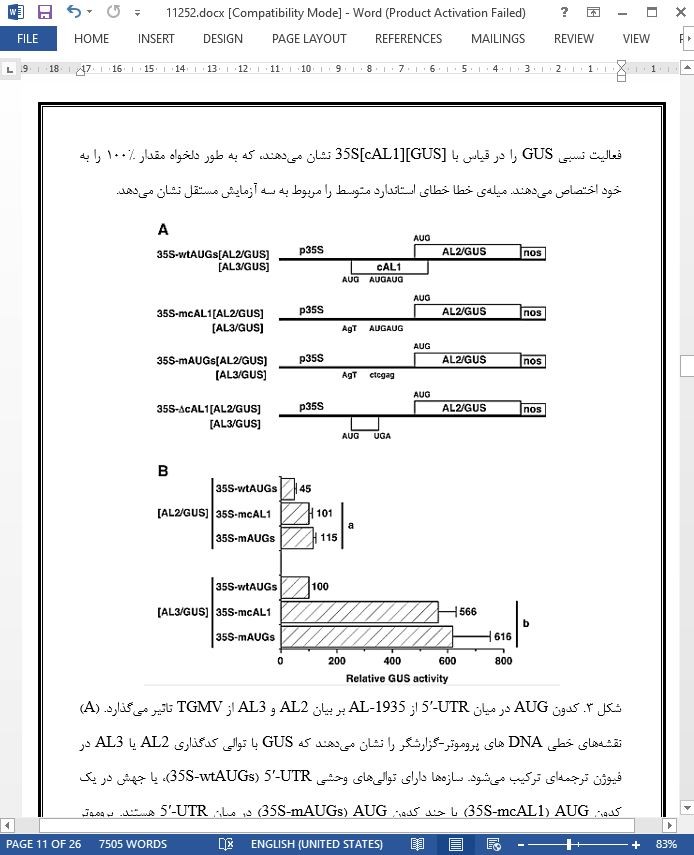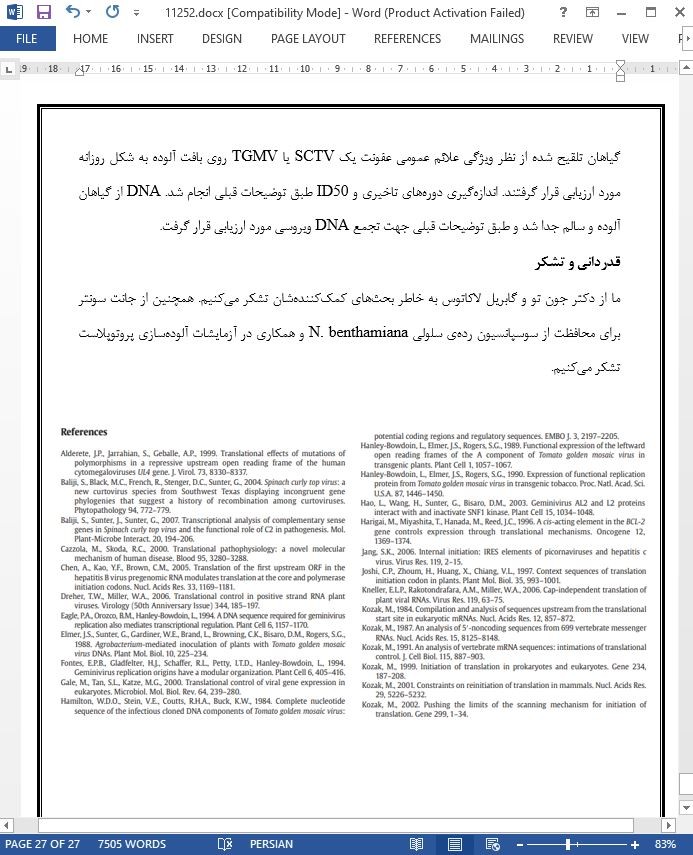
تنظیم بیان ژن AL2 و AL3 ویروس موزاییک طلایی گوجه فرنگی
چکیده
ویژگی مکانیزم تنظیمی ترجمه برای بیان ژن مکمل-سنس ویروس موزائیک طلایی گوجه فرنگی (TGMV) تعیین شده است. TGMV دو رشته ی mRNA به نام های رونوشت AL-1935 و AL-1629 را رونویسی می کند که هر دوی آن ها دارای قالب های آزاد AL2 و AL3 هستند. اما AL2 تنها از AL-1629 بیان می شود در حالی که AL3 از هر دو ناحیه بیان می گردد. سه کدون آغازین ترجمه ی AUG در بالادست هر دو ناحیه ی کدگذاری AL2 و AL3 و میان ناحیه ی غیرترجمه ای (UTR) از رونوشت AL-1935 قرار گرفته اند. ترجمه می تواند از اولین کدون AUG آغاز شود، که 122 اسیدآمینه ی انتهای C را در پروتئین AL1 (cAL1) مشخص می کند. آغاز ترجمه در این کدون AUG برای بیان پایین دست AL2 و AL3 مهارکننده است. علت این امر بیشتر به این موضوع برمی گردد که کدون خاتمه ی cAL1 پس از کدون آغازین AUG برای ORF مربوط به AL2 قرار گرفته است. مکانیزمی که بوسیله ی آن AL3 از AL-1935 بیان می شود، هنوز ناشناخته است اما فاصله ی بین کدون خاتمه ی cAL1 و شروع AL3 پیشنهاد می کند که می تواند در شروع مجدد و/یا آغاز داخلی بیان دخالت داشته باشد. در مقابل، بیان AL3 از AL-1629 به احتمال زیاد به وسیله ی عبور سست ریبوزم اتفاق می افتد زیرا کدون آغازین AL3 قبل از کدون خاتمه ی AL2 قرار دارد. جهش در پروتئین cAL که کد کننده ی AUG در کورتوویروس، ویروس کرلی تاپ اسفناج ، منجر به کاهش کارایی می شود چون در دوره ی تاخیری کوتاهتری اندازه گیری شده است. روی هم رفته این موضوعات پیشنهاد می کند که ژمینی ویروس از مکانیزم تنظیمی پس ترجمه ای برای تنظیم سنتز پروتئین های ویروسی که در همانندسازی و سرکوب دفاع میزبان اهمیت دارند، استفاده می کند.
مقدمه
ژنوم دوقسمتی ویروس طلایی گوجه فرنگی (TGMV)، یک بگومو ویروس ، متشکل از دو جزء DNA به نام های A و B است که حدوداً 6/2 کیلو باز دارد. همانندسازی ژنوم DNA تک رشته ای در هسته ی سلول های گیاهی آلوده رخ می دهد که درنتیجه یک حد واسط DNA دو رشته ای به شکل همانندساز (RF) ایجاد می شود. mRNAهای اختصاصی ویروس از RF DNA به شکل دو جهتی رونویسی می شود و یک ناحیه با حدود 230 توکلئوتید را شکل می دهد که در دو جزء DNA مشترک است (شکل 1A). RNA های ویروسی پلی آدنیله هستند و پایین دست جعبه ی حفظشدهی TATA و نیز عناصر آغازگر که نشانگر ترجمه بهواسطهی RNA پلی-مراز II میزبان هستند، را شروع می کنند. در حال حاضر مشخص نیست که آیا رونوشت های TGMV در انتهای 5́ کلاهکگذاری می شوند یا خیر. یک RNA ویروسی منفرد از DNA مربوط به TGMV رونویسی می شود که از نوکلئوتید 319 (AR-319) آغاز می شود، که الگو را برای ترجمه ی CP آماده می کند. رونویسی رشته ی مکمل-سنس پیچیده تر است، RNAهای همپوشانی را که واجد انتهاهای 5́ متفاوت و انتهای 3́ مشترکی هستند، ایجاد می کند. بزرگترینرونوشت از نوکلئوتید 62 (AL-62) شروع می شود، و کل نیمه ی سمت چپ TGMV A را کد می کند و تنها رونوشتی است که می تواند پروتئین AL1 با طول کامل را کد کند. اما AL-62 همچنین پتانسیل کد کردن پروتئین های AL2، AL3 و AL4 را دارد.
الحاق در گیاه
N. benthamiana سالم، آرابیدوپسیس یا اسفناج (Spinacea oleracea va. viroflay) با استفاده از یک دوز استاندارد (OD600=1.0) طبق آنچه قبلا توضیح داده شد، با کشت های اگروباکتریومی تلقیح شدند که دارای کپی های تکراری از DNA وحشی یا جهش یافته ی SCTV و یا TGMV بودند. گیاهان تلقیح شده از نظر ویژگی علائم عمومی عفونت یک SCTV یا TGMV روی بافت آلوده به شکل روزانه مورد ارزیابی قرار گرفتند. اندازه گیری دوره های تاخیری و ID50 طبق توضیحات قبلی انجام شد. DNA از گیاهان آلوده و سالم جدا شد و طبق توضیحات قبلی جهت تجمع DNA ویروسی مورد ارزیابی قرار گرفت.
Abstract
A translational regulatory mechanism for Tomato golden mosaic virus (TGMV) complementary-sense gene expression has been characterized. TGMV transcribes two mRNAs, AL-1935 and AL-1629 transcripts, both of which contain the AL2 and AL3 open reading frames. However, AL2 is only expressed from AL-1629 whereas AL3 is expressed from both. Three AUG translation initiation codons are located upstream of both the AL2 and AL3 coding regions, within the 5′-untranslated region (UTR) of the AL-1935 transcript. Translation can initiate at the first AUG, specifying the C-terminal 122 amino acids of the AL1 protein (cAL1). Initiation of translation at this AUG is inhibitory for the downstream expression of both AL2 and AL3. This is most likely due to the terminator codon of cAL1 being positioned after the AUG initiation codon for the AL2 ORF. The mechanism by which AL3 is expressed from AL-1935 is currently unknown but a gap between the cAL1 termination codon and the start of AL3 suggests that it may involve reinitiation and/or internal initiation. In contrast, expression of AL3 from AL-1629 most likely occurs via leaky ribosome scanning since the AL3 initiation codon occurs before the terminator codon of AL2. Mutation of the AUG encoding cAL1 in the curtovirus, Spinach curly top virus, leads to increased infectivity as measured by a shorter latent period. Together this suggests that geminiviruses use a post-translational regulatory mechanism to regulate the synthesis of viral proteins important for replication and suppression of host defenses.
Introduction
The bipartite genome of Tomato golden mosaic virus (TGMV), a begomovirus, consists of two DNA components, A and B, of approximately 2.6 kb (Hamilton et al., 1984). Replication of the single stranded DNA genome occurs in the nuclei of infected plant cells producing double-stranded (ds) DNA replicative form (RF) intermediates (Stenger et al., 1991). Virus-specific mRNAs are transcribed from RF DNA in a bidirectional manner from an approximately 230 nt region, common to both DNA components (Fig. 1A) (Fontes et al., 1994; Hanley-Bowdoin et al., 1990; Petty et al., 1988; Sunter and Bisaro, 1989; Sunter et al., 1989, 1993). Viral RNAs are polyadenylated and initiate downstream of either consensus TATA box or initiator elements indicative of transcription mediated by host RNA polymerase II. It is unknown at this time whether TGMV transcripts are capped at the 5′-end. A single virion-sense RNA is transcribed from TGMV DNA A initiating at nt 319 (AR-319), providing the template for translation of CP (Sunter et al., 1989). Complementary-sense transcription is more complex, producing multiple overlapping RNAs with different 5′-ends but a common 3′-end. The largest transcript initiates at nt 62 (AL-62), encodes the entire left side of TGMV A (Sunter et al., 1989), and is the only transcript that can encode full-length AL1 protein. However, AL-62 also has the potential to code for the AL2, AL3 and AL4 proteins.
Plant inoculation
Healthy N. benthamiana, Arabidopsis or spinach (Spinacea oleracea, var. viroflay) were inoculated with Agrobacterium cultures containing either tandemly repeated copies of wild type or mutant SCTV or TGMV DNA, using a standard dose (O.D.600 = 1.0) as described previously (Baliji et al. 2004). Inoculated plants were scored for the appearance of symptoms typical of an SCTV or TGMV infection on systemically infected tissue on a daily basis. Latent periods and ID50 measurements were made as described previously (Sunter et al., 2001). DNA was isolated from infected, and healthy mock-inoculated plants and analyzed for viral DNA accumulation as described previously (Baliji et al., 2007).
چکیده
مقدمه
نتایج
ترجمه می تواند در cAL1 AUG آغاز شود
کدون های AUG در میان 5′-UTR از AL-1935 نقش مهاری در بیان TGMV AL2 و AL3 ایفا می-کنند.
جهش کدون AUG تاثیر ناچیزی بر رونویسی یا بیان خودمختار ویروسی دارد
جهش cAL1 بر بیماریزایی ویروس در اسفناج تاثیر می گذارد
جهش cal1 هیچ تاثیری بر بار ویروس ندارد
بیان AL3 از AL-1629 با کمک عبور سست ریبوزوم
بحث
مواد و روش ها
سازه های DNA
آلودگی پروتوپلاستی و آنالیز
الحاق در گیاه
Abstract
Introduction
Results
The TGMV AL-1935 transcript contains a previously undescribed open reading frame conserved among begomo- and curtoviruses
Translation can initiate at the cAL1 AUG
AUG codons within the 5′ UTR of AL-1935 play an inhibitory role in the expression of TGMV AL2 and AL3
Mutation of the cAL1 AUG codon has little effect on viral replication or autorepression
Mutation of cAL1 affects viral pathogenicity in spinach
Mutation of cal1 has no effect on virus load
AL3 expression from AL-1629 via context-dependent leaky scanning
Discussion
Materials and methods
DNA constructs
Protoplast transfection and analysis
Plant inoculation
- اصل مقاله انگلیسی با فرمت ورد (word) با قابلیت ویرایش
- ترجمه فارسی مقاله با فرمت ورد (word) با قابلیت ویرایش، بدون آرم سایت ای ترجمه
- ترجمه فارسی مقاله با فرمت pdf، بدون آرم سایت ای ترجمه



